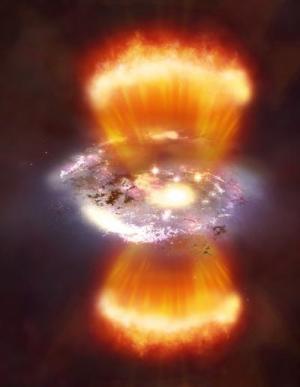About a decade ago, astronomers discovered giant hydrogen gas reservoirs - referred to as 'hydrogen pools' - while surveying young galaxies away from Earth. These lakes emit very vivid light, but the source of the huge energy source needed for the luminescence as well as the nature of the lakes has not been clarified yet.
Recently, for the first time in history, scientists have identified the source of this energy through long-term observations from the Chandra telescope. X-ray data show that a significant source of energy in these massive structures is from giant black holes that are partially obscured by dense layers of gas and dust. Light rays emitted from galactic star formation also play an important role, which is the conclusion drawn through observation on the Spitzer space telescope as well as observations from the ground.
 This is one of two illustrations of a galaxy inside a hydrogen pool when viewed from a relatively close distance. The spiral-shaped arm of the galaxy is yellow and white. A two-way flow powered by a giant black hole inside the galaxy center is shown in bright yellow, above and below the galaxy. This flow illuminates and heats the gas around the galaxy, making it possible to observe hydrogen pools from billions of light years. (Photo: CXC / M. Weiss) 'For 10 years the secret of hydrogen pools has always been hidden, but now we have discovered their energy source,' said James Geach, a scientist with Durham University, UK, said the team leader. 'So far we have been able to conclude the debate about the role of these lakes in the formation of galaxies and black holes.'
This is one of two illustrations of a galaxy inside a hydrogen pool when viewed from a relatively close distance. The spiral-shaped arm of the galaxy is yellow and white. A two-way flow powered by a giant black hole inside the galaxy center is shown in bright yellow, above and below the galaxy. This flow illuminates and heats the gas around the galaxy, making it possible to observe hydrogen pools from billions of light years. (Photo: CXC / M. Weiss) 'For 10 years the secret of hydrogen pools has always been hidden, but now we have discovered their energy source,' said James Geach, a scientist with Durham University, UK, said the team leader. 'So far we have been able to conclude the debate about the role of these lakes in the formation of galaxies and black holes.'
It is believed that galaxies form when air currents move inside under the force of gravity and are cooled by radiation. This process will stop when gas is heated by radiation and currents from galaxies and black holes. Hydrogen can be a sign of the first step, or the second step above.
Based on the new data and theoretical arguments, Geach and his colleagues showed that the warming of gas, not the cooling of gas from growing giant black holes and the stars are the energy supply for hydrogen pools. Thus, these lakes represent a period when galaxies and black holes have just stopped growing under the influence of heating processes. This is an important step in the development of galaxies and black holes - called the "reverse" step - also a step that astronomers have been trying to understand for a long time.
'We see galaxies and black holes inside hydrogen pools that are reaching adulthood and now stop to continue to grow,' said Bret Lehmer, co-author of the study. 'Giant galaxies have to go through this step, otherwise they will form too many stars and are too big to this day.'
The Chandra space telescope and many other telescopes including Spitzer observed 29 hydrogen pools in a large sky field called 'SSA22'. These hydrogen pools, which range in size up to several hundred thousand light years, are seen when the universe is only about 200 billion years old, equivalent to 15% of its current age.
In five of these hydrogen pools, the Chandra telescope has detected the signal of growing giant black holes. Scientists believe that these black holes are at the center of most galaxies today, including our own. According to other observations, including data obtained from Sptizer, the team could determine that some of these galaxies are also governed by different levels of star formation.
Radiation and strong currents from these black holes and star-forming explosions, calculated, are strong enough to burn hydrogen gas in lakes. In the absence of black hole signaling, hydrogen pool is generally weaker. The authors point out that black holes bright enough to power these lakes are still too dim for us to observe from the Chandra space telescope.
In addition to explaining the energy source of hydrogen pools, research results also help to predict their future . In a hot situation, the gas from these lakes will not cool down to form stars but will add to the hot gas between galaxies. SSA22 itself can develop into a giant galaxy cluster.
'Initially hydrogen pools will pour into their galaxies, but what we now see is only the latter part of the process,' Geach said. 'This means that we have to look further into the past to meet the periods of galaxies and black holes that are forming from hydrogen lakes.'
The results will appear in the Astrophysical Journal July 10.
 Van Allen's belt and evidence that the Apollo 11 mission to the Moon was myth
Van Allen's belt and evidence that the Apollo 11 mission to the Moon was myth The levels of civilization in the universe (Kardashev scale)
The levels of civilization in the universe (Kardashev scale) Today Mars, the sun and the Earth are aligned
Today Mars, the sun and the Earth are aligned The Amazon owner announced a secret plan to build a space base for thousands of people
The Amazon owner announced a secret plan to build a space base for thousands of people